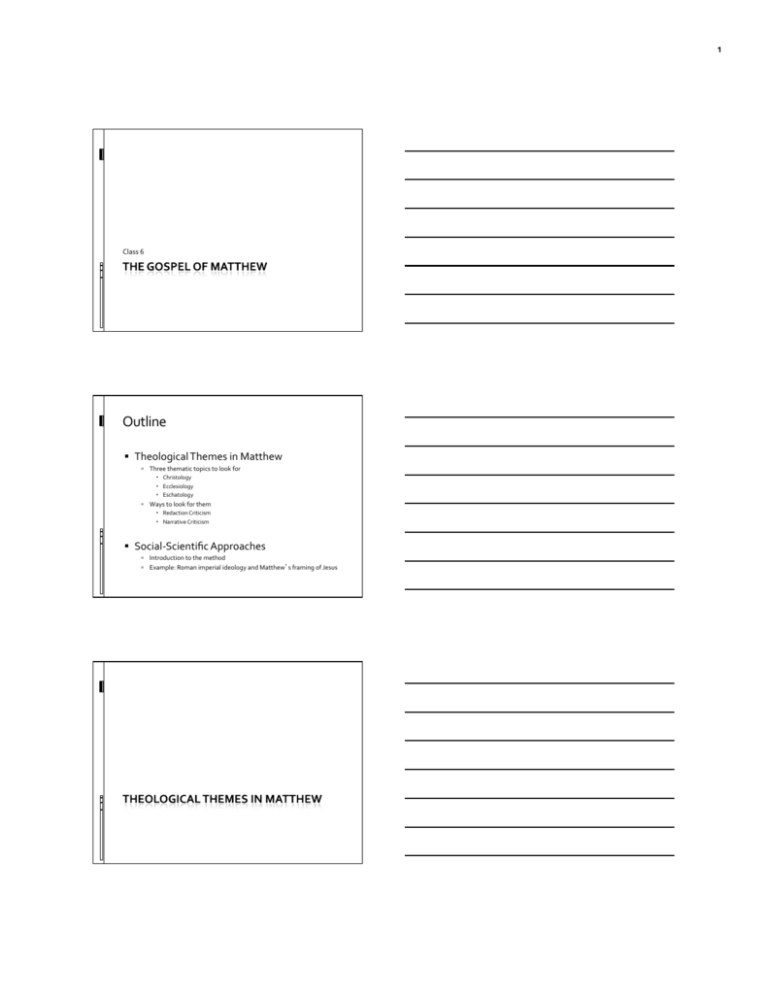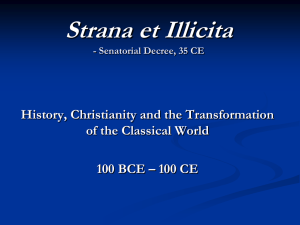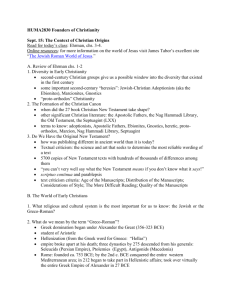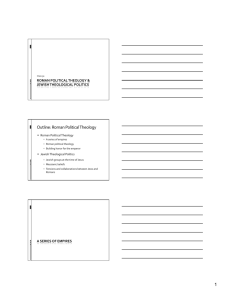The Gospel of Matthew
advertisement

1 Class 6 Outline Theological Themes in Matthew Three thematic topics to look for Christology Ecclesiology Eschatology Ways to look for them Redaction Criticism Narrative Criticism Social‐Scientific Approaches Introduction to the method Example: Roman imperial ideology and Matthew s framing of Jesus 2 Thematic Topics to Look For Christology How Matthew defines the significance of the Christ Ecclesiology How Matthew describes the followers of Jesus and their life together Eschatology How Matthew understands the end times and the place of Jesus life, death and resurrection within them Christology The Significance of the Christ Narrative Critical Clues Redaction Critical Clues Jesus represents the fulfillment of scripture § 47, 111, 113 Messiah, Son of the living God, Son of Man, § 158, 254 Immanuel (God with us), Jesus (God saves) David Christology 1–2; 27:11-31 Moses Christology 2:13-23; 5–7;17:1-9 Jesus as divine Wisdom 11:19-27 Discourses Earliest Trinitarian formulation (28:19) Ecclesiology The Nature of the Church Narrative Critical Clues Redaction Critical Clues Jewish law is fulfilled, but Gentiles are also included 2:1-12; 25:31-46 Church is founded; Peter is rock on which § 158, 147 it s built Characteristics of community life are described The kingdom ≠ the church, but the church is where Jesus is confessed as Lord The kingdom of heaven is transferred to a people who will bear fruit § 85, 339 Discourses 2 & 4 (mission and community) 25:31-46 § 341 3 Eschatology Jesus Role in the End Times Narrative Critical Clues Redaction Critical Clues Natural phenomena signal the decisive 2:2 § 347, 352 change that Jesus life and death inaugurate Many precepts are MORE difficult than Jewish law = an end‐time ethics? See M and Q material added at § 57-59 § 55-56 Analytical Categories drawn from the social sciences Social Systems Social institutions kinship, politics, economics, religion, education, medicine, legal system, military Values Qualities that shape behavior Person types Individualistic or collectivist Sanctions and rewards anxiety honor/shame innocence/guilt 4 Steps of Social‐Scientific Method Select a suitable and accepted model 1. 2. Use the model to form adequate scenarios for reading a gospel Ap p pro An ach ro ti nis method is both historical and literary c? But because it also utilizes a sociological or anthropological ? e‐ ki oo C Because the target is the world of the gospel, the te? ria ter cut model, it features theory and comparative analysis more explicitly than the historical or literary approaches we have examined 7 Generalizations for Reading Matthew How social‐scientific exegetes view the NT world 1. All goods are limited; social interactions outside one’s group are win/lose 2. The subsistence economy resulted in a present (not future) orientation 3. There was no sense of history, as something qualitatively different from the present 4. The supernatural was not regarded as supernatural, but as an aspect of the natural 5. Religion and economics were not free‐standing institutions; they were embedded in kinship and politics 6. Domestic religion was characterized by remembering ancestors; to some extent, this characterizes political religion as well. 7. People were defined by the collective, not by individualism or introspection; that is one reason there were no authors of the gospels An Application of Social‐Scientific Criticism • Develop a description of Roman political theology (religion is embedded in politics; both deploy ancestor reverence in service of collective identity) • Use description to “read” Matthew’s Christology 5 Earlier Empires Assyrian (749-609 BCE) Earlier Empires Babylonian (609-539 BCE) Earlier Empires Persian (550-330 BCE) 6 Earlier Empires Hellenistic (c. 332 BCE) FROM REPUBLIC TO EMPIRE POMPEY 63 BCE JULIUS CAESAR 49-44 BCE OCTAVIAN, aka CAESAR AUGUSTUS 27 BCE–14 CE 7 Roman Eschatology 1. Augustus presented himself as an agent of restoration, not innovation • stability • prosperity • moral renewal 2. His poets and propaganda praised him as a kind of heaven‐sent agent • Virgil’s Aeneid aligns Augustus with the founder of Rome • Augustus aligns himself with gods of peace, victory, abundance on coins and statues 3. In fact this propaganda was meant to offset the radical innovation that Augustus represented: breaking from republican traditions and establishing himself as the sole ruler Ara Pacis Augustae, Rome Ara Pacis Augustae, Rome 8 Octavian denarius Winged victory on ship’s prow holding wreath/crown of victory Emperor on chariot, holding olive branch Inscription: Imp[erator] Caesar Octavian denarius, 19‐18 BCE Caesar Augustus “Caesar’s Comet” 7‐day comet the appeared during the Ludi Victoriae Caesaris a few months after Julius Caesar was assassinated, taken as a symbol of his deification by Octavian Inscription: Divvs Ivliv THE AUGUSTAN BUILDING PROGRAM: POMPEII 9 Octavian denarius, 32‐29 BCE Bust of Octavian (Augustus Caesar) Pax, holding olive branch and cornucopia Inscription: Caesar Divi F Gaulanitis Galilee 63 BCE Pompey takes region for Rome 40 BCE Roman senate appoints Herod “King of the Jews” Samaria Perea Judea Gaza Idumea 37 BCE Herod secures control 37 ‐ 4 BCE Launches a huge building and infra‐ structure program, honoring the Emperor wherever he can 10 Gaulanitis Galilee 4 BCE Herod dies, and 3 sons split his kingdom Samaria 6 CE Herod Archelaus can’t control the south, so the Romans take over direct administration Perea Judea Gaza Idumea Herod Antipas builds the city of Tiberias to honor the new emperor in 20 CE Gaulanitis Galilee 4 BCE Herod dies, and 3 sons split his kingdom Samaria 6 CE Herod Archelaus can’t control the south, so the Romans take over direct administration Perea Judea Gaza Idumea 40 CE Rome grants Herod Agrippa I the entire region; he promotes Roman interests aggressively, increasing tension 66‐74 CE First Jewish Revolt; Temple destroyed Gospels begin to be written 11 An Application of Social‐Scientific Criticism • We’ve developed a description of Roman political theology and seen how the Herodian dynasty and allied aristocrats demonstrated allegiance to Rome and the Emperors • Now we want to use these insights to “read” Matthew’s Christology The Mimicry of Roman Political Theology in Matthew Titles for God & Jesus • Abba vs. pater patriae • Son of Man coming as judge • King of the Jews • Soter (Savior) • Son of God (Diuus filius) Kingdom of Heaven • Sick are healed • People are fed • Inclusive table fellowship Term for the gospel itself • Euangelion = good news








